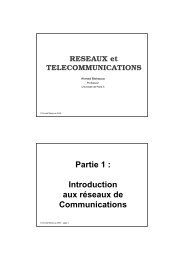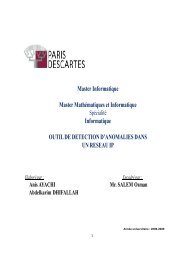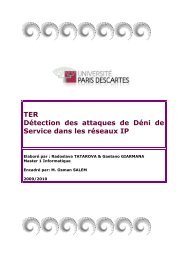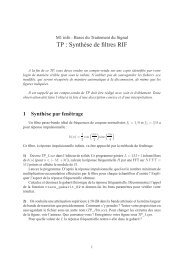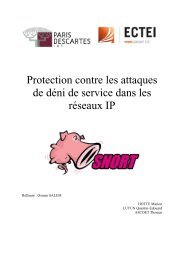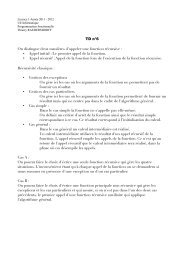Th`ese de Doctorat de l'université Paris VI Pierre et Marie Curie Mlle ...
Th`ese de Doctorat de l'université Paris VI Pierre et Marie Curie Mlle ...
Th`ese de Doctorat de l'université Paris VI Pierre et Marie Curie Mlle ...
Create successful ePaper yourself
Turn your PDF publications into a flip-book with our unique Google optimized e-Paper software.
Shenker in [10] states that the n<strong>et</strong>work service mo<strong>de</strong>l can be augmented with admission<br />
control, which is the ability to turn some flows away when the n<strong>et</strong>work is overloa<strong>de</strong>d. In<br />
other words, the n<strong>et</strong>work should turn away additional flows when admitting them would<br />
lead to violating its quantitative service commitments. Therefore, in our work, we assume<br />
the existence of admission control algorithms at the edge [20, 21, 22] of the n<strong>et</strong>work that<br />
cooperate with our proposed bandwidth allocation algorithms operating insi<strong>de</strong> the n<strong>et</strong>work.<br />
In the following, we present a brief review of two classes of admission control algorithms<br />
proposed in the literature.<br />
In [20], the authors propose an endpoint admission control scheme which avoids the<br />
complexities of per-flow state in n<strong>et</strong>work routers. The basic i<strong>de</strong>a is that the end hosts (or<br />
edge routers) probe the n<strong>et</strong>work by sending pack<strong>et</strong>s at the rate that a new flow would like to<br />
reserve. The flow is admitted if the resulting loss rate of probing pack<strong>et</strong>s is sufficiently low.<br />
Alternatively, the admission control test can be performed based on available bandwidth<br />
measurements, avoiding the negative effect of losses.<br />
The scheme <strong>de</strong>scribed in [21] is part of a more general admission control scheme that<br />
bases pricing on ECN (Explicit Congestion Notification) marks. All pack<strong>et</strong>s are treated<br />
i<strong>de</strong>ntically: data and probe pack<strong>et</strong>s are indistinguishable, as are best-effort and real-time<br />
pack<strong>et</strong>s, and they are marked upon congestion. Flows can send as much traffic as they<br />
wish, but must pay for those pack<strong>et</strong>s that are marked. In this s<strong>et</strong>ting, admission control is<br />
a service offered by third-parties (or the n<strong>et</strong>work itself) to provi<strong>de</strong> a guaranteed price for<br />
the flow (as opposed to guaranteeing the level of service, in traditional IntServ).<br />
31



